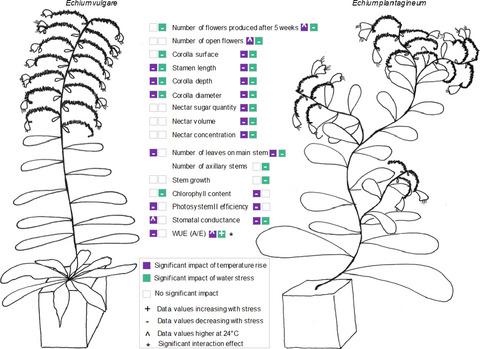当前位置:
X-MOL 学术
›
Ecol. Evol.
›
论文详情
Our official English website, www.x-mol.net, welcomes your
feedback! (Note: you will need to create a separate account there.)
Species-specific responses to combined water stress and increasing temperatures in two bee-pollinated congeners (Echium, Boraginaceae).
Ecology and Evolution ( IF 2.3 ) Pub Date : 2020-05-20 , DOI: 10.1002/ece3.6389 Charlotte Descamps 1 , Sophie Marée 1 , Sophie Hugon 1 , Muriel Quinet 1 , Anne-Laure Jacquemart 1
中文翻译:

两种蜂授粉同源植物(蓝蓟属、紫草科)对水分胁迫和温度升高的综合反应的物种特异性。
更新日期:2020-07-25
Ecology and Evolution ( IF 2.3 ) Pub Date : 2020-05-20 , DOI: 10.1002/ece3.6389 Charlotte Descamps 1 , Sophie Marée 1 , Sophie Hugon 1 , Muriel Quinet 1 , Anne-Laure Jacquemart 1
Affiliation

|
- Water stress and increasing temperatures are two main constraints faced by plants in the context of climate change. These constraints affect plant physiology and morphology, including phenology, floral traits, and nectar rewards, thus altering plant–pollinator interactions.
- We compared the abiotic stress responses of two bee‐pollinated Boraginaceae species, Echium plantagineum , an annual, and Echium vulgare , a biennial. Plants were grown for 5 weeks during their flowering period under two watering regimes (well‐watered and water‐stressed) and three temperature regimes (21, 24, 27°C).
- We measured physiological traits linked to photosynthesis (chlorophyll content, stomatal conductance, and water use efficiency), and vegetative (leaf number and growth rate) and floral (e.g., flower number, phenology, floral morphology, and nectar production) traits.
- The physiological and morphological traits of both species were affected by the water and temperature stresses, although the effects were greater for the annual species. Both stresses negatively affected floral traits, accelerating flower phenology, decreasing flower size, and, for the annual species, decreasing nectar rewards. In both species, the number of flowers was reduced by 22%–45% under water stress, limiting the total amount of floral rewards.
- Under water stress and increasing temperatures, which mimic the effects of climate change, floral traits and resources of bee‐pollinated species are affected and can lead to disruptions of pollination and reproductive success.
中文翻译:

两种蜂授粉同源植物(蓝蓟属、紫草科)对水分胁迫和温度升高的综合反应的物种特异性。
水分胁迫和气温升高是气候变化背景下植物面临的两个主要制约因素。这些限制影响植物生理学和形态学,包括物候、花性状和花蜜奖励,从而改变植物与传粉者的相互作用。
我们比较了两种蜜蜂授粉的紫草科物种(一年生植物Echium plantagineum和两年生植物Echium vulgare )的非生物胁迫反应。植物在开花期在两种浇水方式(充分浇水和水分胁迫)和三种温度方式(21、24、27°C)下生长了 5 周。
我们测量了与光合作用(叶绿素含量、气孔导度和水分利用效率)、营养性状(叶数和生长速率)和花性状(例如花数、物候、花形态和花蜜产量)相关的生理性状。
两个物种的生理和形态特征均受到水和温度胁迫的影响,尽管一年生物种的影响更大。这两种压力都会对花的性状产生负面影响,加速花的物候,减小花的大小,并且对于一年生物种来说,减少花蜜的回报。在水分胁迫下,这两个物种的花朵数量都减少了 22%–45%,从而限制了花朵奖励的总量。
在水分胁迫和气温升高(模拟气候变化的影响)的情况下,蜜蜂授粉物种的花卉特征和资源受到影响,并可能导致授粉和繁殖成功的破坏。









































 京公网安备 11010802027423号
京公网安备 11010802027423号